There are more than 500 species of shark swimming on planet Earth. In every nook, cranny, and corner of the ocean, from the warmest regions to the Arctic, various types of sharks can be found. Most of these species, of course, we’ll never encounter or even see in an aquarium. But, with such a huge variety of sharks in our waters, it can lead you to wonder which ones you’re most likely to bump into. And if you’re an angler, you may be curious about which ones are most likely to end up tugging at your line. That’s not a question only people targeting sharks need to consider. The reality is that more sharks are caught in U.S. waters as bycatch than on purpose.
Despite the wide range of species that exist in our waters alone, the sad truth is that sharks are in big trouble globally. Thanks in large part to illegal shark-finning operations
, many species that thrived just decades ago are endangered or getting very close to becoming endangered. That’s not to suggest no one targets sharks with a rod and reel anymore, but attitudes about shark fishing have certainly changed. Between many species having no-kill restrictions placed upon them, plus a strong catch-and-release ethic among modern shark hunters, we’re much more conscious about shark conservation versus past eras where so many were killed for little more than bragging rights.
Even if you have no interest in catching a shark, spend enough time soaking bait and working lures in U.S. salt waters and you’re likely to tie into one eventually. Here are the types of sharks that are most likely to grab hold from the bay to offshore waters.
Table of Contents
Blacktip Shark
Blue Shark
Bonnethead Shark
Bull Shark
Dusky Shark
Great Hammerhead Shark
Great White Shark
Lemon Shark
Nurse Shark
Sandbar Shark
Sand Tiger Shark
Shortfish Mako Shark
Smooth and Spiny Dogfish
Thresher Shark
Tiger Shark
Types of Sharks
1) Blacktip Shark
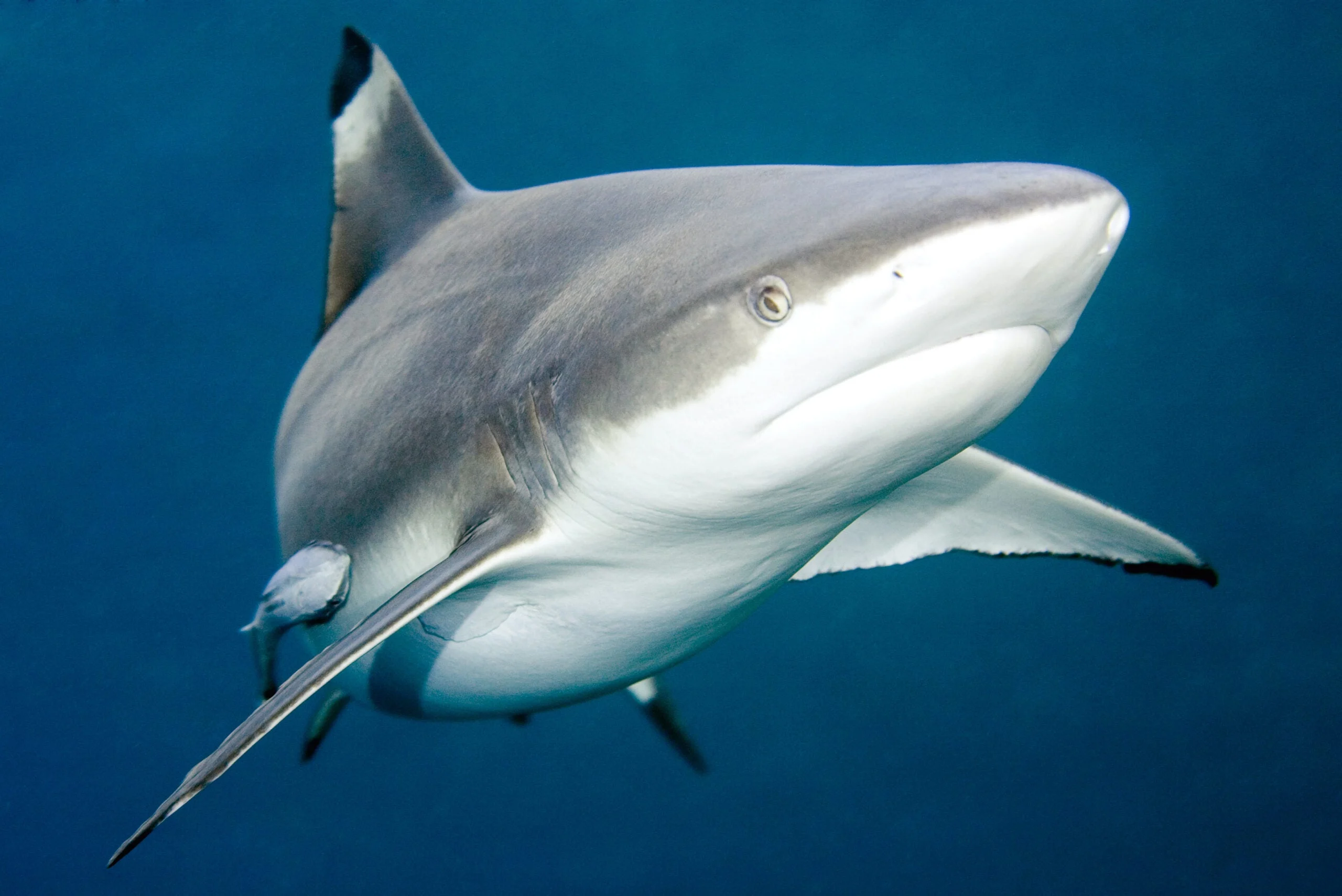
Blacktip sharks have a cult following among Florida anglers. cbpix/Adobe Stock
Range: Canadian Maritimes to the Texas Coast, California Coast
Of all the types of sharks frequently found inshore and even right in the waves, blacktips arguably have the biggest cult following. This is particularly the case in Florida, even though these sharks can be caught throughout the Gulf and as far north as New England. Unlike most sharks that prefer a big, greasy chunk of bait sitting on the bottom, blacktips are keen to chase live prey, which means they’ll hit a wide variety of lures. You can also go fly fishing for blacktip sharks
.
During seasonal spawning and baitfish runs that bring blacktips tight to the beach in Florida, anglers employ stout spinning rods and big topwater poppers. When one of these sharks goes in for the kill, the surface smash is epic, and your reel’s drag is going to scream. Though blacktips can grow up to 8 feet long, they’re more common in the 3- to 5-foot range, making them manageable to fight and land—though your shoulders will hurt.
Unlike many sharks, blacktips are not protected, as their population is presently in good shape. Though it’s not widely popular, some anglers specifically target them for the table, as the meat is said to be to be sweet and mild.
2) Blue Shark

If they’re in the area, blue sharks are typically suckers for cut-bait rigs. prochym/Adobe Stock
Range: Canadian Maritimes to the Texas Coast, California to Southern Alaska
For many offshore anglers, blue sharks are a consolation prize. Those out targeting mako sharks, thresher sharks
, or tuna often must suffer through the “blue dogs” when they’re thick. Blue sharks thrive in warm and cold water alike, making them one of the most abundant species around the globe, though it’s rare for them to be caught within sight of land in most areas.
Blue sharks will grab any cut bait
you’re using, and occasionally even attack lures and flies. Though they can reach upwards of 9 feet, they’re weak fighters compared to other shark species. They also have no real food value, so aside from looking sleek and cool when they come to the boat lit up in their signature electric blue, they’re not highly prized by U.S. anglers. In Great Britain, conversely, they’re an extremely popular target, as the cold water in the North Atlantic doesn’t offer as much shark variety as we have in the States.
3) Bonnethead Shark
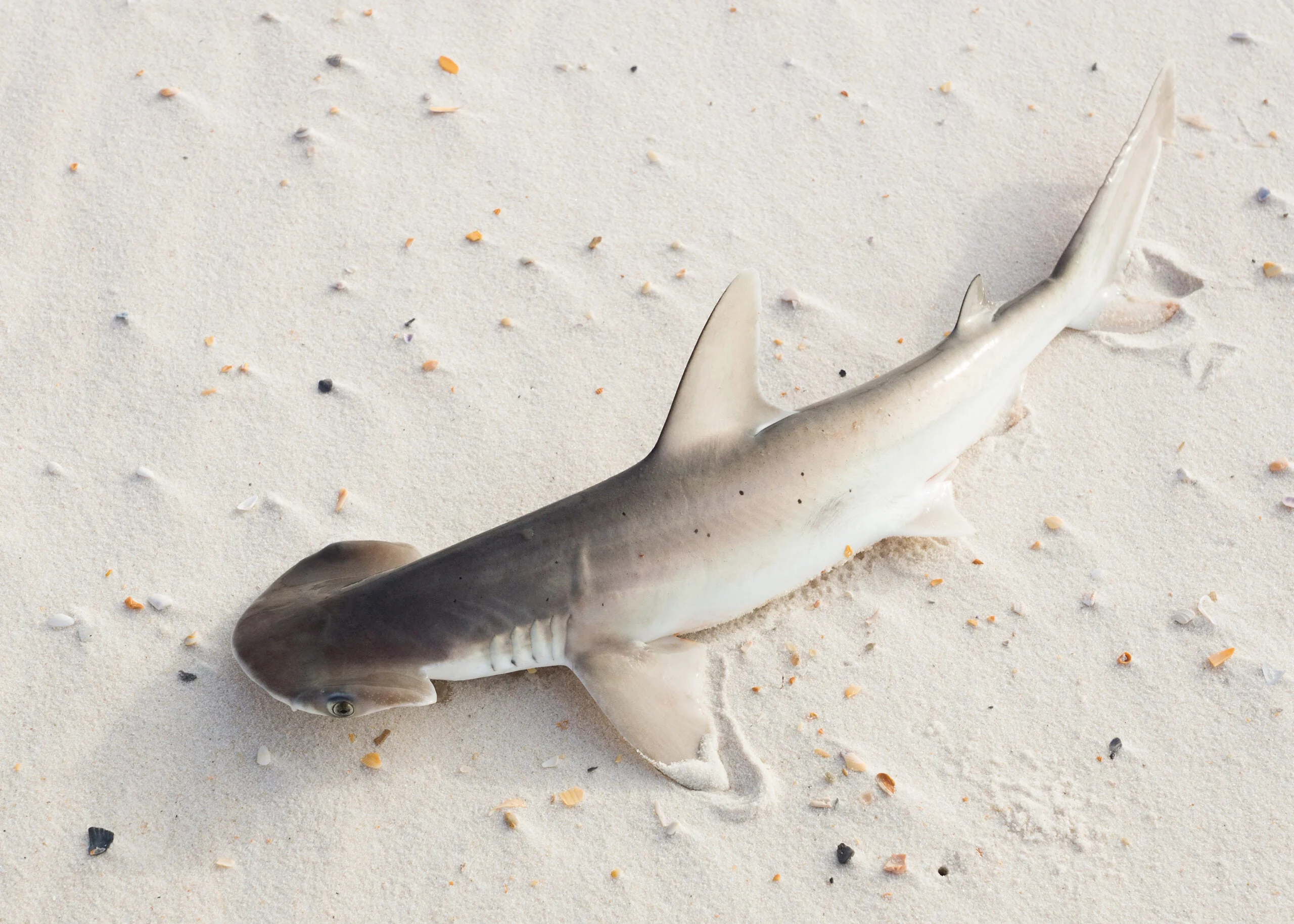
Bonnetheads are found in shallow waters, making them good targets in the flats or from the beach. Irina K./Adobe Stock
Range: Mid-Atlantic to the Texas Coast
Bonnethead sharks are smallest members of the hammerhead family, rarely growing longer than 4 feet in length. Although this type of shark can be found as far north as New Jersey, you’re most likely to hook one fishing the clear waters of Florida and the eastern Gulf Coast. They are particularly abundant in shallow waters, making them common bycatch for anglers fishing the surf or wading flats in tidal bays and rivers. Bonnetheads will snatch up any live or dead bait you’re casting, and while they might be small, they do have teeth, so use pliers to remove the hook and handle them with care.
4) Bull Shark
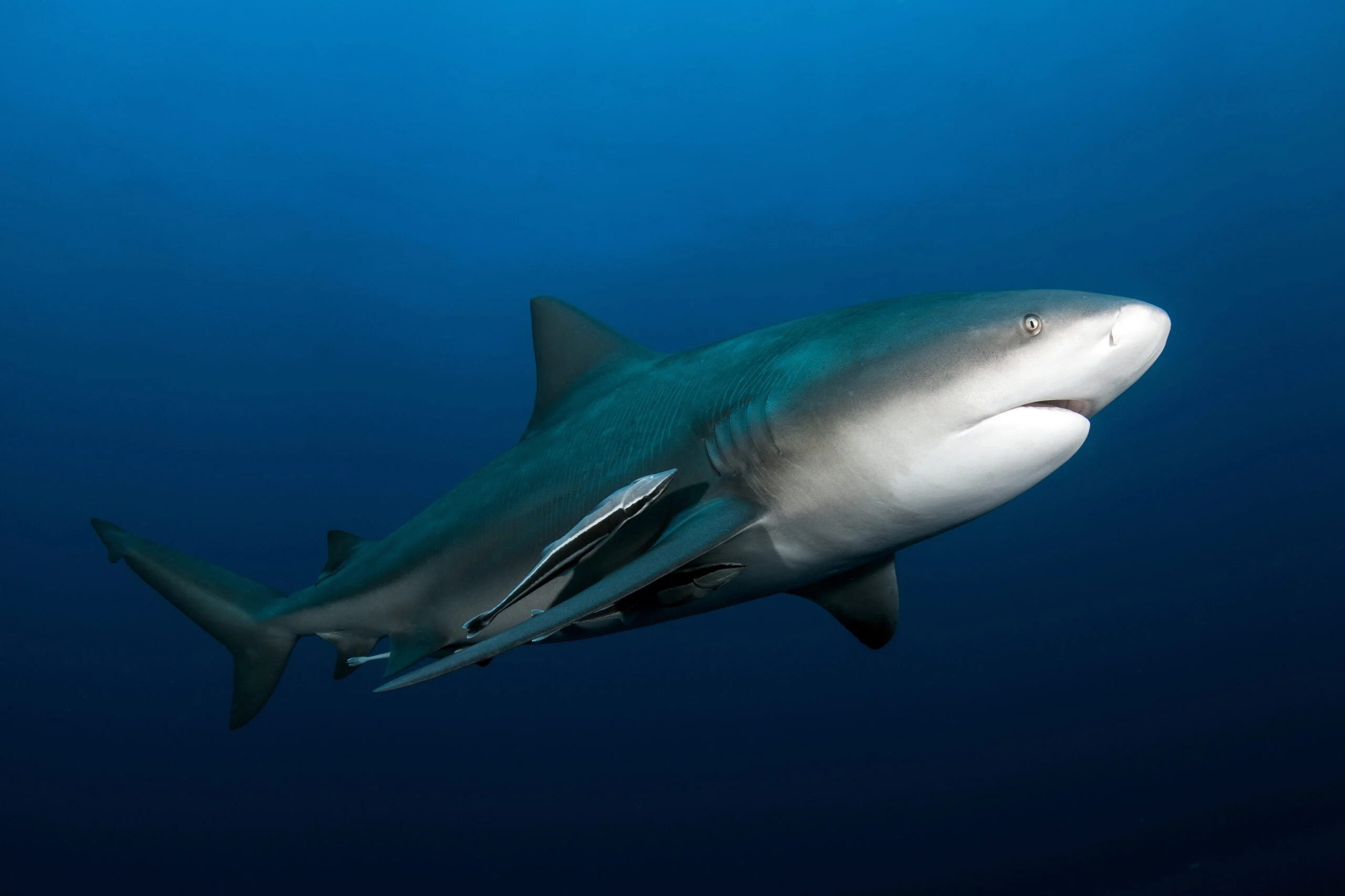
If you hook into a bull shark, be extremely careful when releasing it. These guys are mean. Tomas/Adobe Stock
Range: Mid-Atlantic to the Texas Coast, Southern California Coast
Thanks to Jaws, many people think great whites are the scariest sharks in the ocean. Wrong. Bull sharks take top honors, not only because they’re meaner and more aggressive than great whites, but because they prefer to live in shallow waters where you’re more likely to be swimming—and fishing.
Capable of reaching 12 feet in length and weighing hundreds of pounds, bull sharks are perfectly comfortable living and hunting in murky tidal river waters, bays, and right in the oceanfront surf. They can even tolerate a higher level of freshwater than any other shark species, and they’ve been fingered as the culprit in vicious shark attacks
miles inland.
Unless you bump into a juvenile bull shark, an adult isn’t likely to grab a small piece of cut bait like other types of sharks. They will, however, attack the bluefish or redfish
or snook you’re fighting. Targeting bull sharks from the beach requires highly specialized gear and tactics, and while they’re frequently hooked as bycatch offshore, not many anglers target them specifically. Even if you tie into a small one, however, use extreme caution when setting it free.
5) Dusky Shark
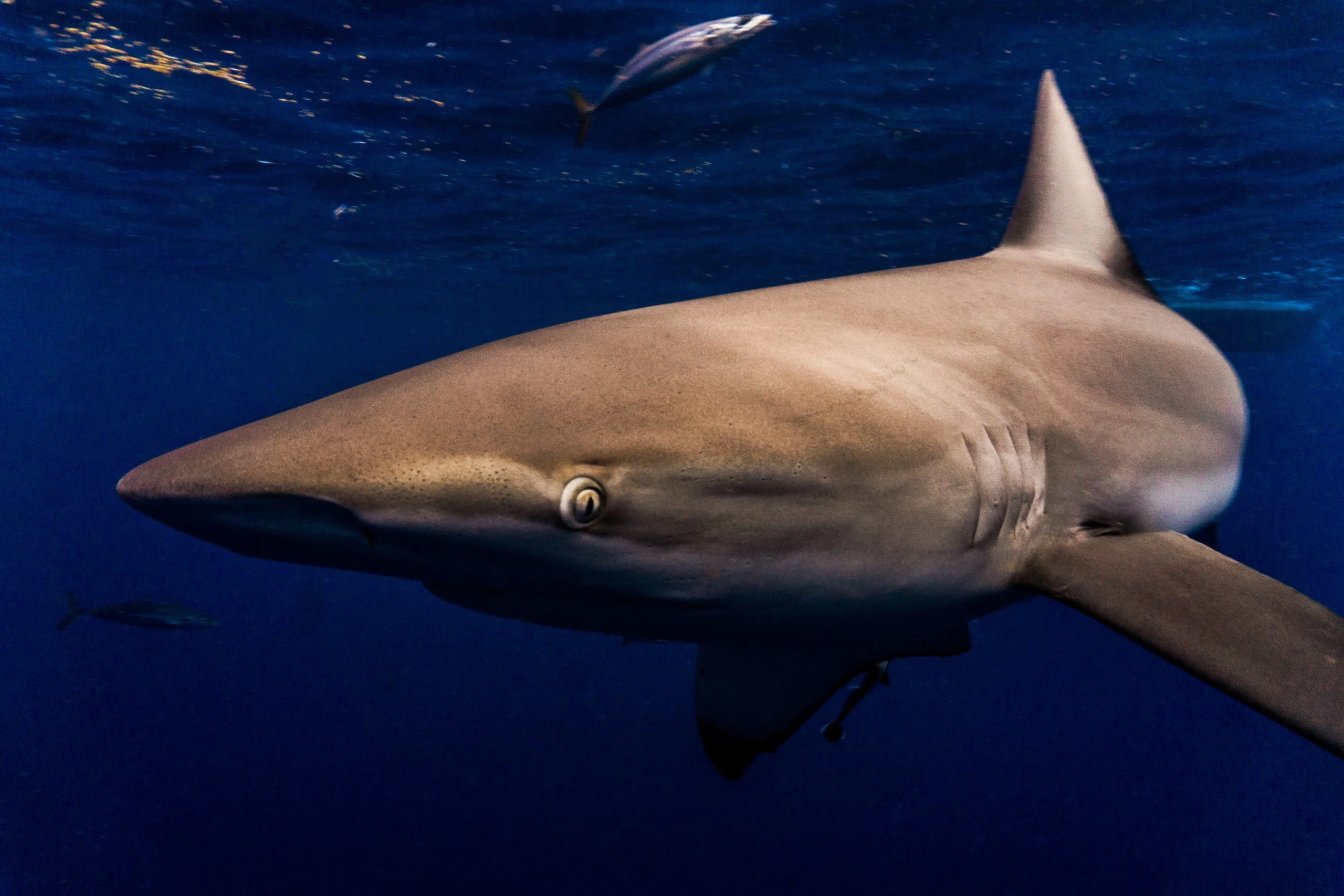
Dusky sharks are protected. If you catch one, reel it in and release it quickly. Jacob/Adobe Stock
Range: Canadian Maritimes to the Texas Coast, California Coast
Duskies are one of the slowest growing types of sharks on the planet, taking nearly 20 years to fully mature. They can grow up to 12 feet long and reach weights of several hundred pounds. They’re also found in every temperate ocean in the world, and they’re abundant both inshore and offshore.
With a dull gray to brown body, anglers often have difficulty distinguishing between a dusky and a sandbar shark. The most notable difference is that a dusky’s nose is rounder and blunter while a sandbar’s is sharper and more pointed. You’re also just as likely to catch both in the same area, as they coexist in many regions. They also feed in the same waters, including right in the surf.
Like sandbar sharks, duskies are highly protected and cannot be killed, so work quickly to release them in good health should you happen to land one.
6) Great Hammerhead Shark

Hammerheads are commonly seen, and caught, close to beaches. nicolasvoisin44/Adobe Stock
Range: Carolinas to the Texas Coast, Southern California Coast
With the ability to reach nearly 20 feet in length, great hammerheads are formidable. And while this type of shark roam the open ocean and live in deep water, many people don’t realize that these giants spend a lot of their time very close to the beach, as well as right in the waves in Florida and along much of the Gulf Coast.
Hammerheads are protected, though they are still occasionally caught and released by anglers that want to really test their mettle against one of the biggest sportfish in the ocean. Because hammerheads live so close to land, this feat is also much more attainable than, say, catching a 1,000-pound marlin, which requires a big boat and mountains of gear. Every season, legions of land-based shark anglers across the South tussle with giant hammerheads, and the fights can sometimes last for hours depending on their size.
If you’re worried about hooking a great hammered as bycatch, however, you really shouldn’t. Unless you’re specifically appealing to them by soaking a giant fish head on a massive hook, they’re not likely to grab the average live or cut bait. They will occasionally attack a fish your fighting, and they can be so thick in certain Florida inlets rife with tarpon that losing your prized silver king to a hammerhead is a very real concern.
7) Great White Shark
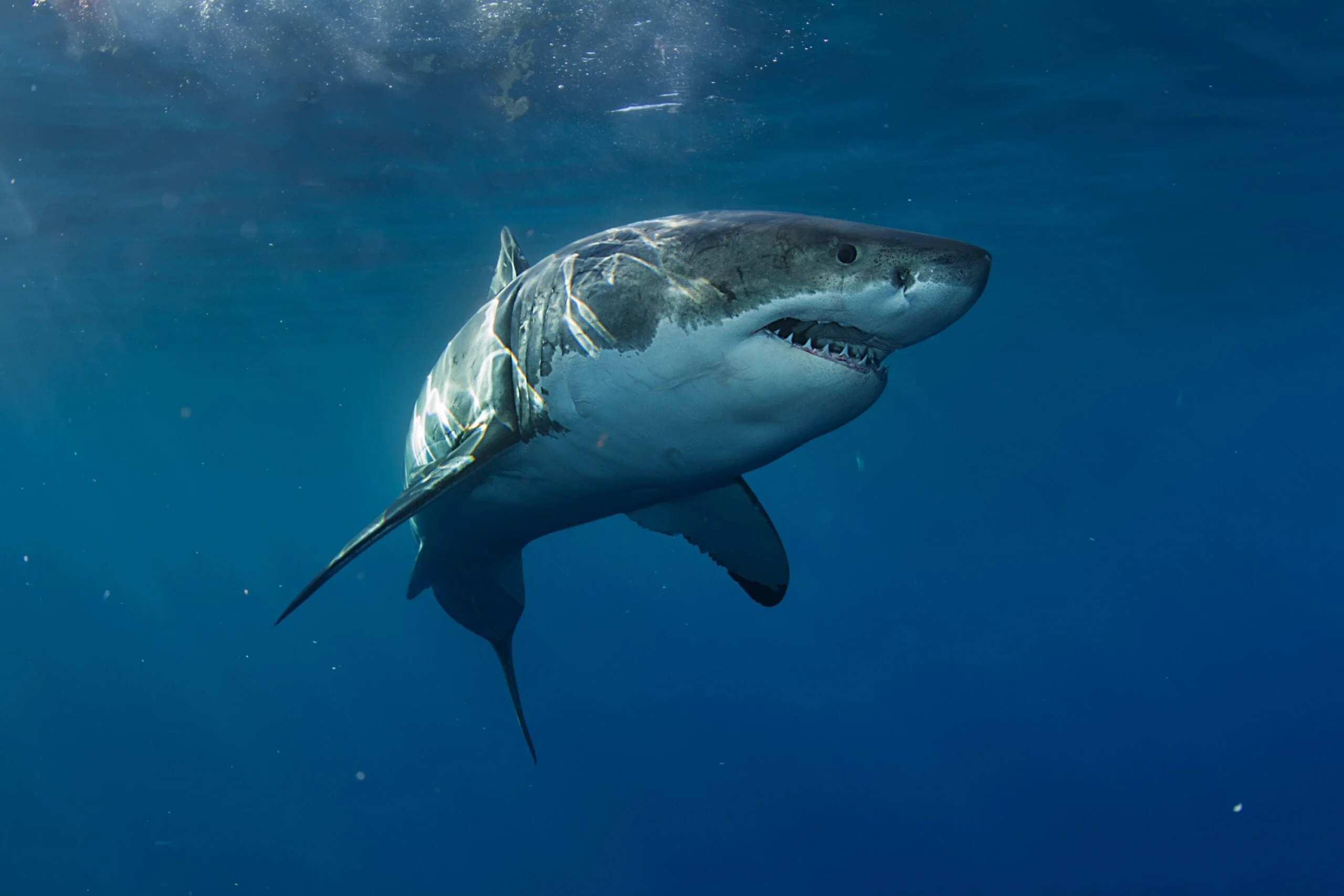
If you happen to hook a great white, cut the line immediately. willyam/Adobe Stock
Range: Canadian Maritimes to the Texas Coast, California to Alaska
Do you view the mighty great white as a mythical beast with one of the most powerful animal bites
that is reserved for fictional characters like Captain Quint to battle? Do you think of them as a fish lurking in the deepest parts of the ocean? The truth is, you’re more likely to encounter a great white in sight of the beach than many other types of sharks species. Tagged great whites routinely ping very close to popular swimming beaches from Massachusetts to Florida, and it’s more common than you think for a white to end up on an angler’s line.
In decade’s past, great whites were fair game for fishermen. Giants measuring more than 20 feet long would be hung on marina scales in places like Montauk, New York, and Cape Cod routinely. Thankfully, great whites have been protected across the globe for many years now. They are in essence one of the most off-limits fish in the ocean. Considering they were mostly killed for photos and bravado instead of food, their protection is a good thing that’s helping the population rebound. While a handful of captains in the U.S. hold special permits that allow them to target and tag great whites, recreational anglers are advised to cut the line as soon as a white is positively identified. Even fighting the fish to the boat can cause more harm than letting it trail a bit of line until the hook rusts out.
8) Lemon Shark
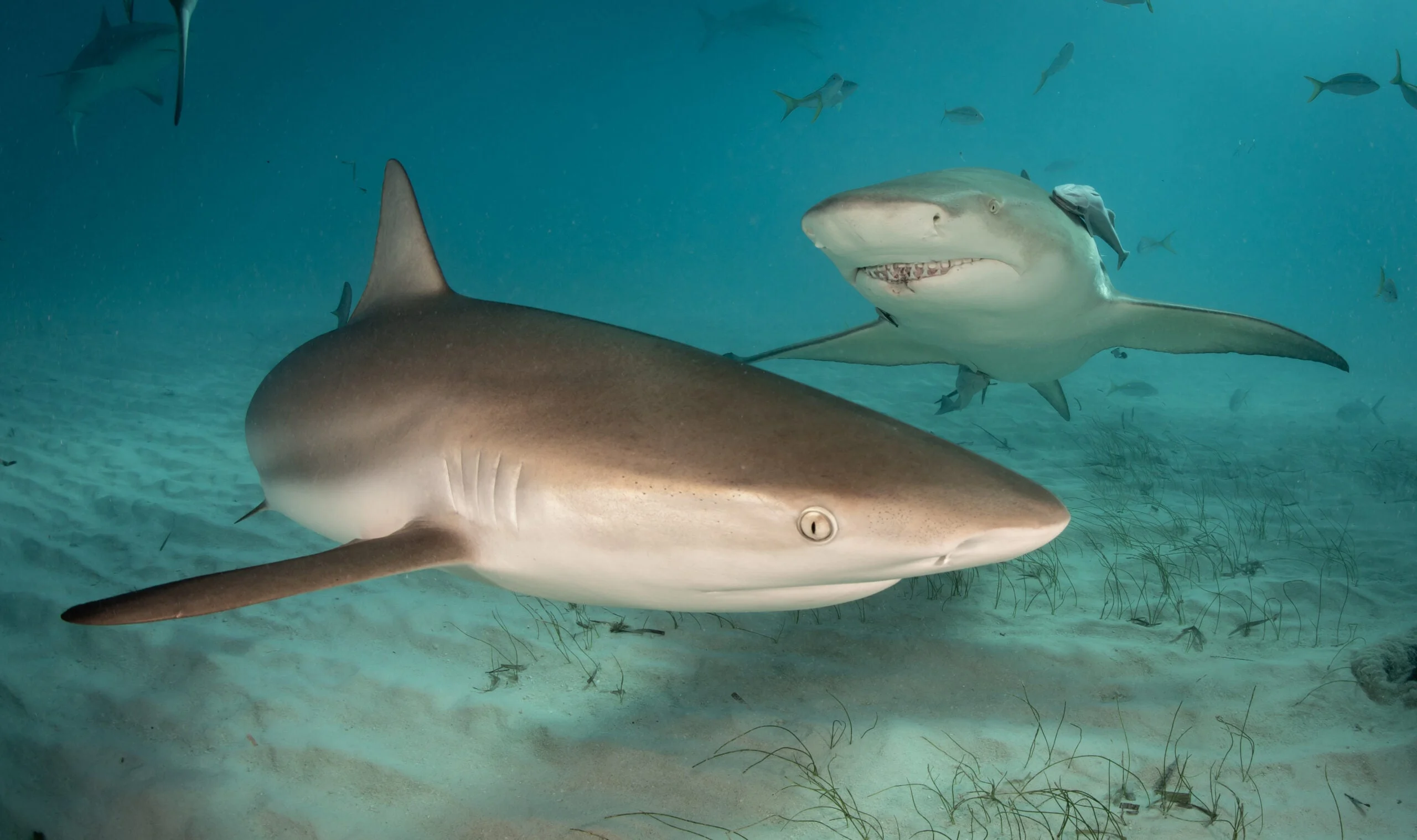
A reef and lemon shark prowl a beach on the Bahamas. Drew/Adobe Stock
Range: Mid-Atlantic to the Texas Coast
Lemon sharks can grow upwards of 9 feet long and weigh north of 300 pounds. They thrive in warm waters, making them most abundant from the Carolinas to Texas, though in the summer months they can be found as far north as New York and Rhode Island. While big lemon sharks are caught frequently by boating anglers fishing offshore, it’s the juveniles you’re more likely to bump into on or close to shore.
Small lemon sharks can be especially plaguing to flats fishermen chasing bonefish, permit, and tarpon in extremely shallow water. Not only will they gobble up a piece of fresh shrimp or mullet sitting on the bottom, but they’ll also chase down lures and flies. Most of the time, unless you’re prepared and rigged with steal leader as a bite guard, even a small lemon shark will quickly cut you off. If it doesn’t, though, you’d better hope your fly reel holds plenty of backing and your spinning reel spool is full, because lemon sharks run hard and fast when pinned.
Lemon sharks also fight to the bitter end, so even when you’re dealing with a small one, take them seriously, especially if you’re wading. They can be aggressive, and their teeth are no joke.
9) Nurse Shark

Nurse sharks are bottom-feeding vacuums that’ll suck up soaking chunks of bait—even if they’re reserved for other gamefish. Drew/Adobe Stock
Range: Mid-Atlantic to the Texas Coast
Nurse sharks are kind of a scourge. Though they straggle as far north as Virginia, they’re most abundant from the Carolinas to the tip of Florida on the Atlantic Coast, and throughout the Gulf from Florida to Texas. Nurse sharks are primarily bottom feeders, which is why their mouths are positioned on the underside of their flat heads. From lobsters to fish to crabs, they’ll suck anything off the sea floor, and if you’re soaking a chunk of cut bait for grouper or tarpon or anything other than nurse sharks, they’ll find it and Hoover that up, too.
Nurse sharks are arguably the biggest annoyance in Florida, particularly to inshore anglers and those fishing on foot from bridges, piers, and in the surf. These fish can top 100 pounds, but despite their size, reeling one in is the equivalent of cranking up a few sacks of potatoes. They don’t do much other than spin and twist, but because of their weight and stamina, you’ll waste a lot of time—and potentially destroy your gear—landing one to get your rig back. You’ll know you’ve got one if you think you’re snagged on the bottom and the bottom suddenly starts to move. Although it’s legal to take a nurse shark, very few people harvest them for the table.
10) Sandbar Shark
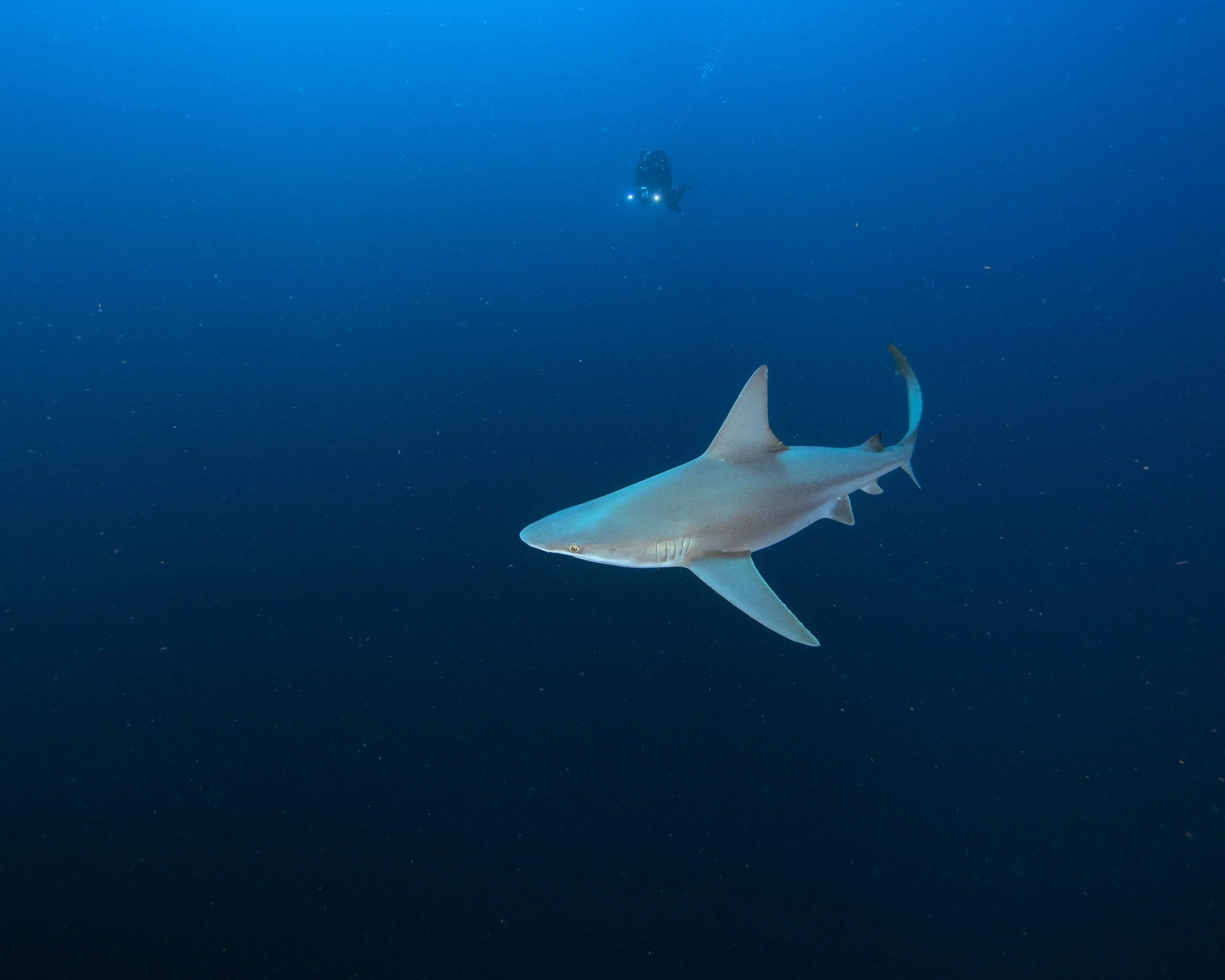
What sandbar sharks lack in looks, they make up for with fighting speed—and flavor. Unfortunately, they’re a protected species. kuldive/Adobe Stock
Range: Canadian Maritimes to the Texas Coast
Sandbar sharks—sometimes referred to as brown sharks—can grow well over 100 pounds, though it’s more common to catch them in the 20- to 70-pound range. Compared to other sharks, sandbars are kind of basic in terms of aesthetics. They have no defining stripes, markings, or features, and they’re teeth are very small. That said, they’ll dump 100 yards of line off your reel in a flash, which makes them a popular target throughout their range, particularly among surfcasters as sandbar sharks feed very close to the beach. The only problem is that you’re not really supposed to fish for them.
Years ago, before sandbars were protected, they were especially popular in the Northeast, as the region doesn’t have the same variety of inshore shark species as places like Florida and Texas. They’re abundance made it possible for shore-bound anglers, and those with small boats only capable of getting a few miles offshore, to tussle with some truly worthy opponents. What’s more, sandbar sharks were fairly desirable on the table, having a mild flesh that was great on the barbecue. Nowadays, you can’t kill a sandbar shark, and though you’re technically not supposed to target them, thousands of anglers skirt this by saying they’re just soaking baits and can’t help what comes along and eats them.
The reality is that they’re claim isn’t inaccurate. Whether you’re casting menhaden chunks in the New Jersey surf, soaking mullet on a Carolina beach, or dropping strip baits to snapper in the Gulf of Mexico, there’s always a possibility that a sandbar will end up pinned on your hook. Smaller ones can be beaten with standard boat and surf gear, but unless you have a reel with a top shelf drag that holds plenty of line, bigger sandbars often get the best of many unsuspecting bait soakers. If you do land one, try not to take it out of the water, don’t risk its healthy by posing for pictures, and carefully use pliers or a de-hooker to remove the hook and get it on its way as quickly as possible.
11) Sand Tiger Shark
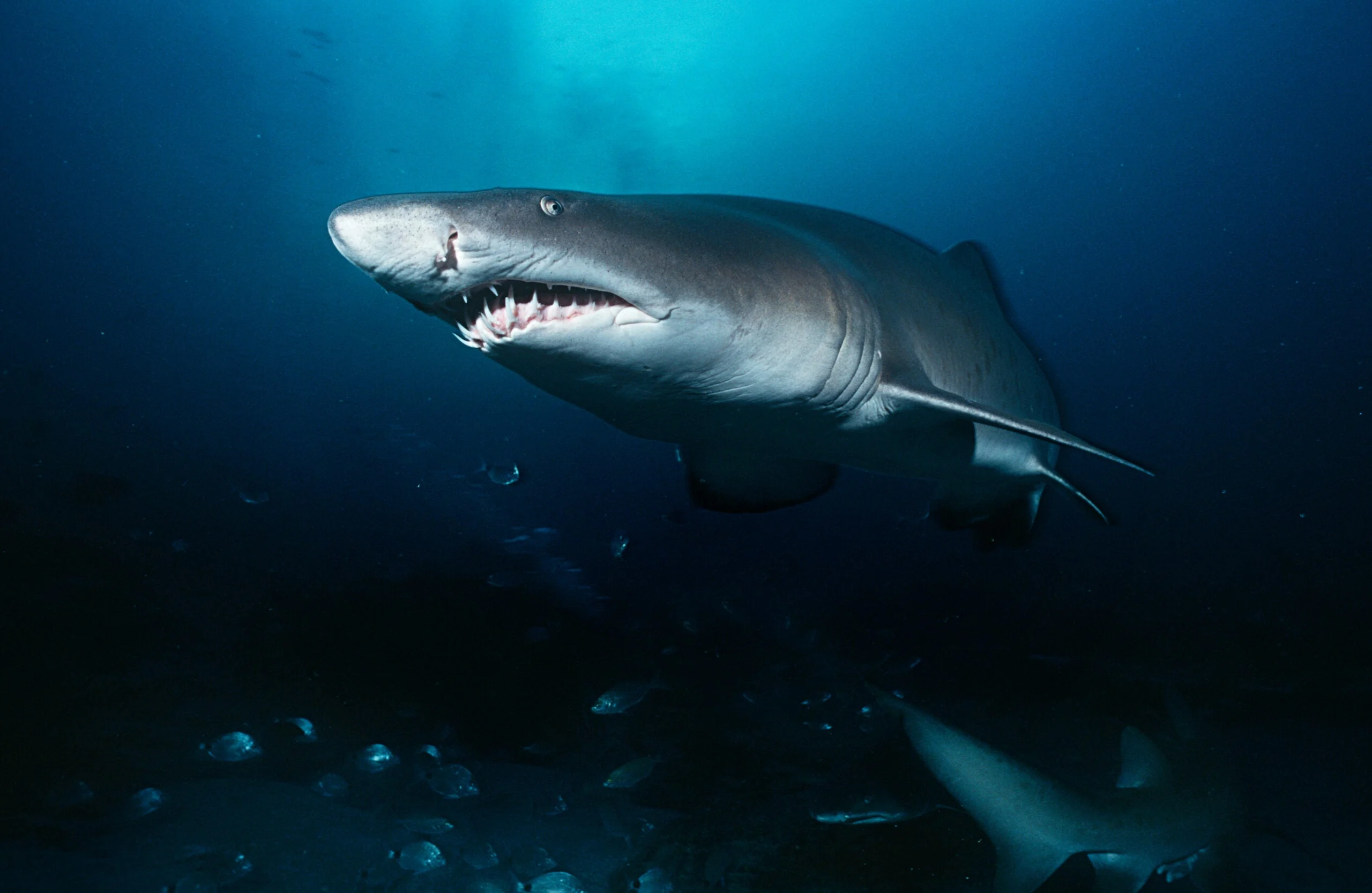
Sand tigers certainly fit the bill of a “scary looking” type of shark. Moodboard/Adobe Stock
Range: Canadian Maritimes to the Texas Coast
Overview
If you’ve visited an aquarium anywhere in the country, you’ve probably gawked at a live sand tiger shark. They’re practically a requirement in the big, main tank because they play into the worldview of sharks being scary. Sand tigers can weigh several hundred pounds. They’re hulking fish made of pure muscle. They have beady little eyes and, most impressively, a mouth full of gnarly, protruding, long dagger-like teeth. You could say staring one down is the stuff of nightmares, but the reality is that sand tigers are one of the most passive sharks in the world.
These gentle giants behave more like catfish than maneaters. In fact, as frightening as those slim needle teeth may look, they’re designed to hold very small prey items they snatch along the bottom—not to take a chunk out of your calf.
Sand tigers can be found in deep water around reefs and wrecks; however, they tend to gravitate to shallow near-shore areas, including within the surf line from Massachusetts to Florida. Because of this, they routinely grab cut baits intended for other targets. The truth is, despite their fierce looks and muscular build, they don’t put up a tremendous fight. They’re kind of lazy and just use their weight to tire you out. That said, sand tigers are highly protected. It is illegal to target them specifically, and if you do hook into one inadvertently, it’s critical to remove or clip the hook as quickly as possible, never take the shark out of the water, and execute a strong, healthy release sans haste.
12) Shortfin Mako Shark
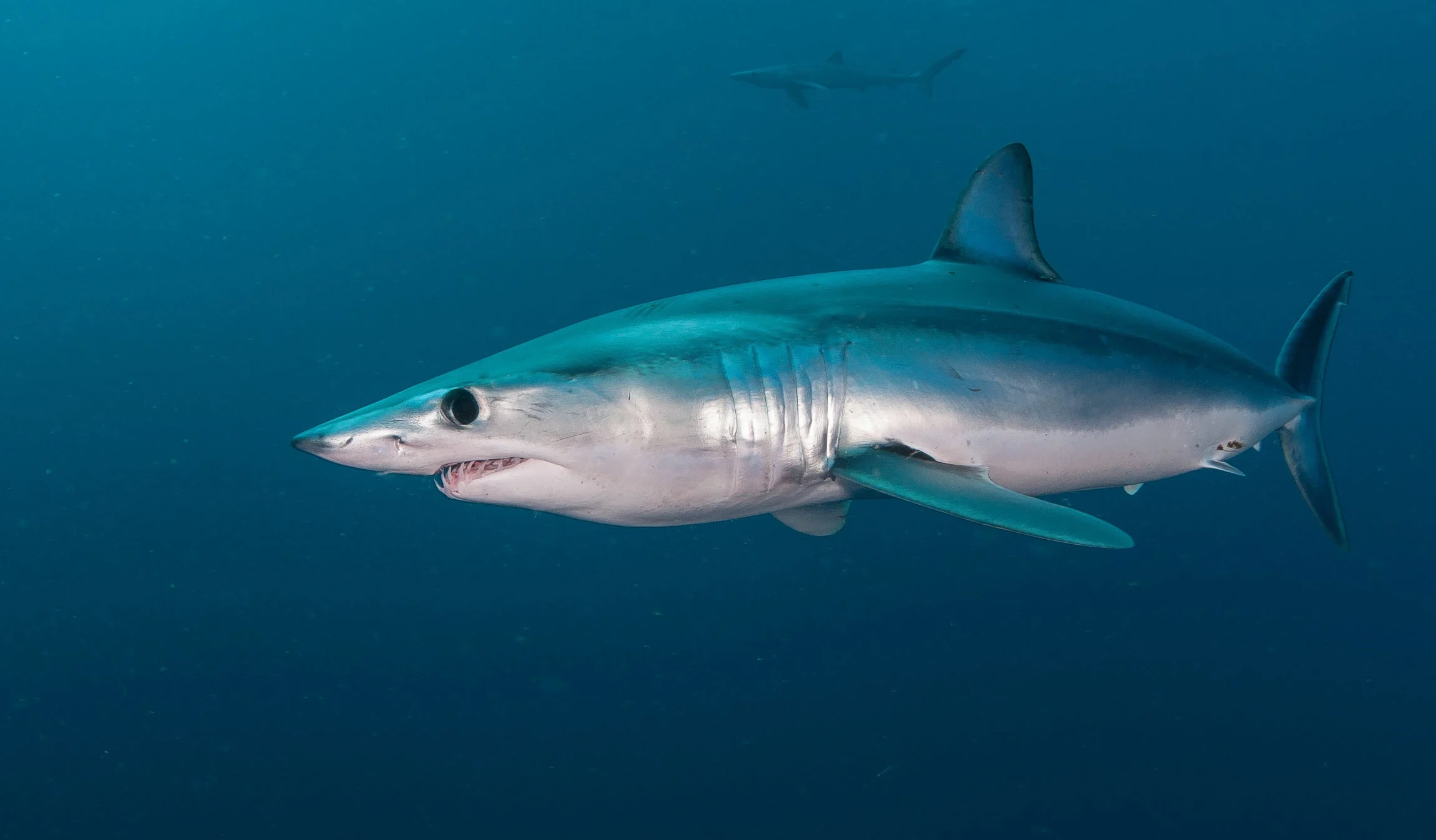
Before a moratorium was placed on them, makos were considered one of the ultimate gamefish to target. izenkai/Adobe Stock
Range: Canadian Maritimes to the Texas Coast, California to Washington
For decades, the shortfin mako was the most coveted types of sharks in U.S. waters. Capable of reaching upwards of 1,000 pounds, makos prompted hundreds of tournaments on every coast, and were lumped in with other offshore prizes like tuna and marlin in terms of popularity. Brute fighters that put on incredible air shows when hooked, makos would really test your strength, and if you won the battle you were treated to some of the most delicious, buttery meat you could find. For better or worse (depending on who you ask), those days are over. Just recently, a moratorium was placed on makos in the Atlantic, and one had existed much longer in the Pacific. So desired were makos that we nearly fished them to extinction.
Naturally, the moratorium is a good thing for the future of the species. For anglers who grew up chasing them, of course, the loss of the ability to harvest them stings. You can still catch and release mako sharks but considering the cost of fuel required to reach them, bait, and tackle, most devout mako hunters moved on to other species when the ban went into effect.
Though makos have been caught in the surf, it’s incredibly rare. These fish thrive in clear, warm, blue offshore waters. Even if you’re not fishing a big piece of mackerel or bluefish to entice them, makos are notorious for their speed, and they’ll often grab a trolling lure intended for marlin or tuna.
13) Smooth and Spiny Dogfish

A spiny dogfish is the most common type of shark you’re likely to catch. Anion/Adobe Stock
Range: Canadian Maritimes to the Texas Coast
Dogfish are one of the most ubiquitous shark species on the planet. With slim bodies, sharp, angled heads, and large oval-shaped eyes, these fish rarely measure longer than 40 inches and are most commonly seen in the 12- to 30-inch range. Smooth and spiny dogfish look almost identical save for the namesake spikes on the back of the spiny dogfish. Just forward of each dorsal fin, a thick, needlelike spine protrudes from the spiny dogfish’s skin and make no mistake—if you catch one it will twist and roll and whip its tail in an attempt to drive one of those spines into your flesh, so handle them with care. Smooth dogfish can be grabbed barehanded across the back sans worry, but while neither species has impressive teeth, you still wouldn’t want to stick a finger in their mouths.
By and large, dogfish are considered a trash species in the U.S. They are, however, first on the list of types of sharks you’re most likely to encounter because they can be found everywhere from back bays to tidal rivers to the oceanfront surf to wrecks in deep water 50 miles off the coast. No matter what species of fish you’re targeting, if you’re using live or cut bait and there are dogfish around, they’ll eat it. At times they can be so thick it’s positively frustrating.
Neither smooth nor spiny dogfish are particularly hard fighters, which doesn’t help their popularity status among anglers. What’s ironic, though, is that in Europe they’re prized for their pure white, mild flesh. In fact, it’s often what you’re served in fish and chips shops in the U.K. Despite this, the number of American anglers that have tried them is low, but those who have are often blown away by how good these fish taste. If you catch one and want to try it, just make sure to gut and bleed it as soon as possible, and then get it on ice fast and keep it cold until you’re ready to fillet, bread, and drop it in the grease.
14) Thresher Shark
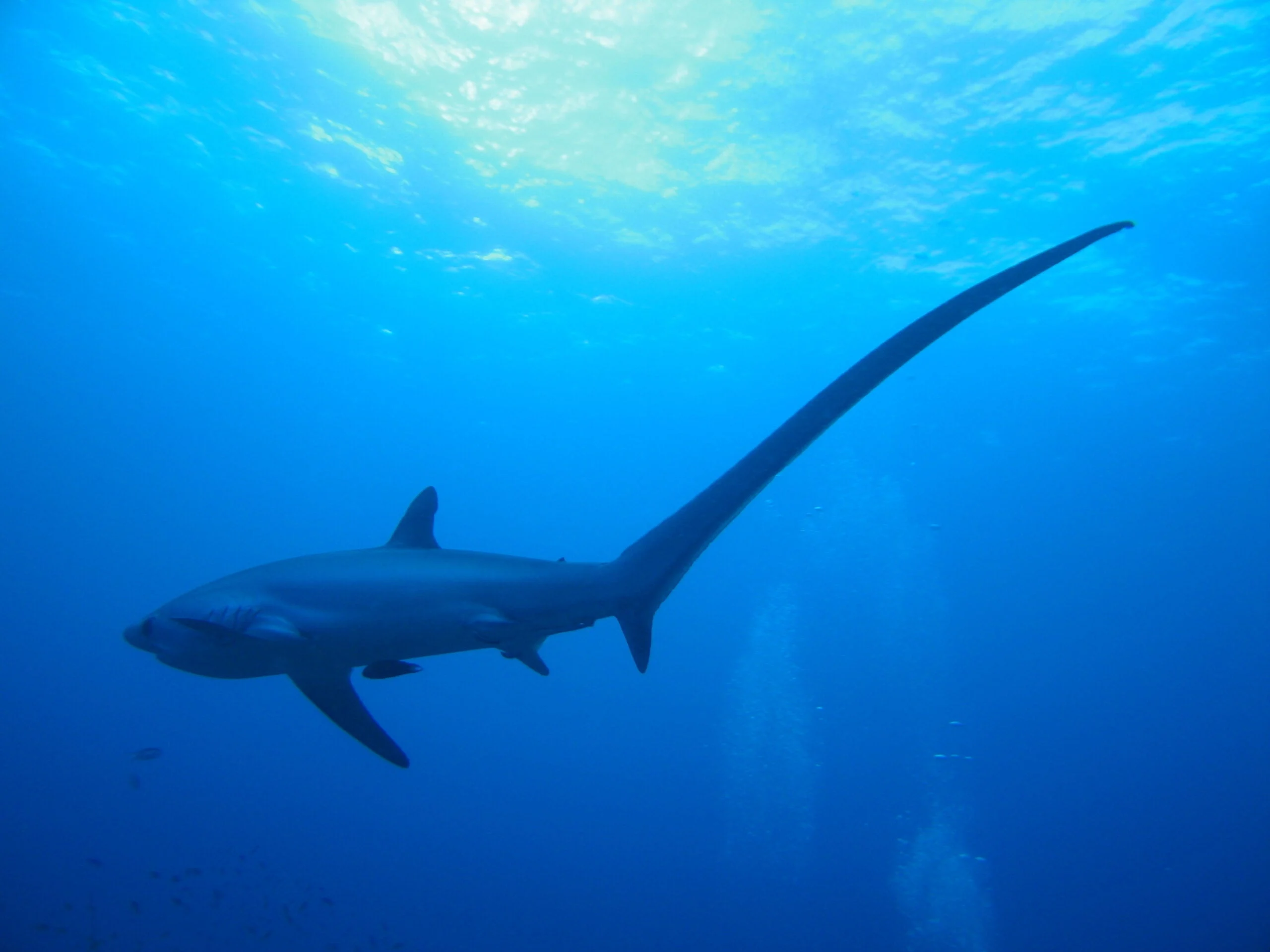
There is no mistaking a thresher for any other type of shark. Aline Hebenstreit/Adobe Stock
Range: Canadian Maritimes to the Texas Coast, California to Washington
Even if you’re dealing with a thresher that weighs 500 pounds or more, most of their length is found in their tails. In fact, it’s not uncommon for their long, whip-like tails to account for half their total length. Those tails are designed to knock prey out, and you’ll often see a thresher in a bait school using it to slap and slice the surface trying to stun prey. They do this because despite their overall size they have very small mouths and teeth, making it easier to slurp up a comatose meal than chase down a live one. While bigeye threshers are highly protected, common threshers are not, making them popular targets, particularly in the Northeast.
A thresher steak rivals a swordfish steak in terms of taste and texture. And while you can catch this type of shark far offshore, they’ll often be hooked within site of the beach, especially during seasonal menhaden migrations that provide an abundance of protein-rich food. Threshers are frequently hooked by anglers targeting striped bass, sea bass, and summer flounder, and they’ve got no problem eating a relatively small piece of bait. Furthermore, because of their small teeth, it’s not unreasonable for them to stay pinned despite a lack of steel bite leader. The problem is that threshers brawl, often leaping ten feet in the air during the battle. Those hooked incidentally are routinely lost because of this, but for those using proper gear to handle a thresher’s hard runs, a delicious meal can be the reward.
15) Tiger Shark
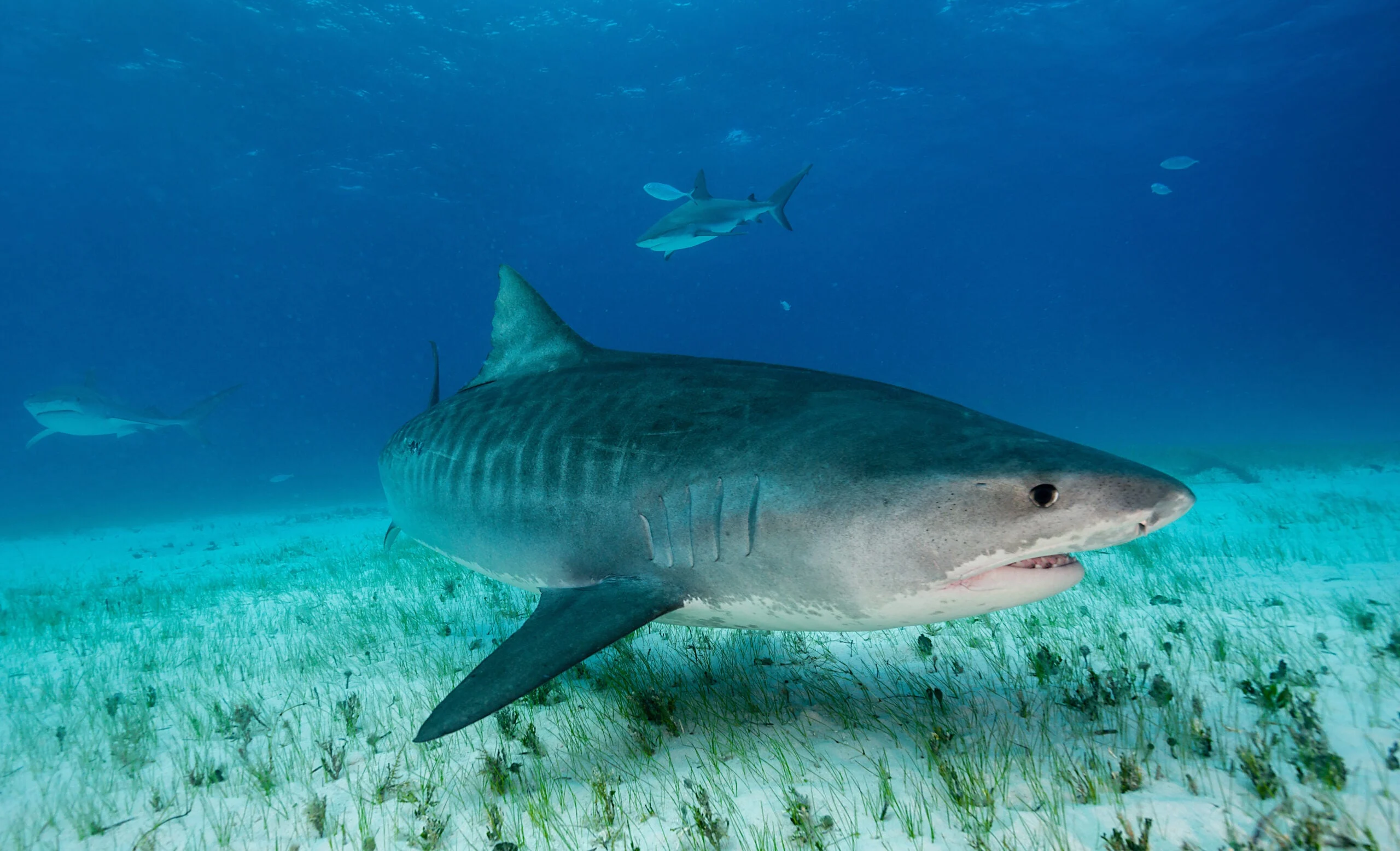
A tiger shark stalks a beach near Grand Bahama. wildestanimal/Adobe Stock
Range: Carolinas to the Texas Coast, California Coast
Like the great hammerhead, tiger sharks are massive, often exceeding 13 feet in length. And, also like hammerheads, they are comfortable feeding in shallow water. The difference is that it’s a bit rarer to tie into a tiger in the surf or off a pier than it is a hammerhead, though ironically, the all-tackle world-record tiger that held from 1964 to 2004 was hooked from a pier in South Carolina. It weighed 1,780 pounds.
Today, tiger sharks are considered threatened, and they’re protected in the U.S. Though they’re rarely targeted on purpose for sport, anglers fishing large cut baits for deep-water reef species like snapper and grouper will sometimes end up in a battle with this type of shark or lose out on some delicious grouper fillets when a tiger snatches the catch off their line.


